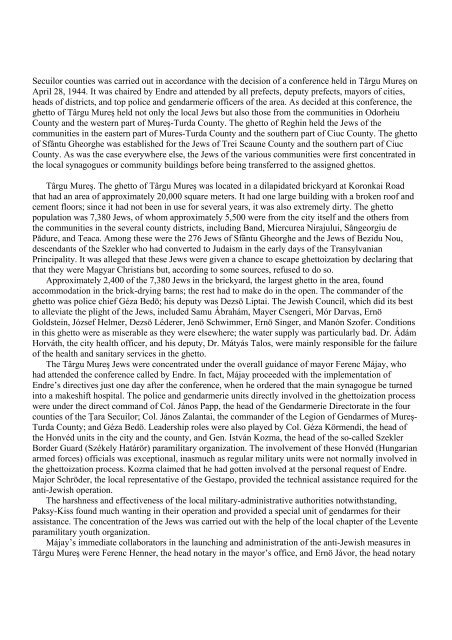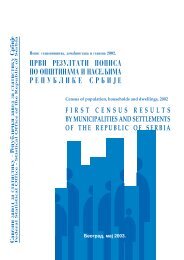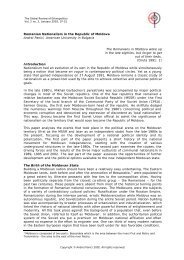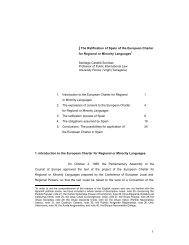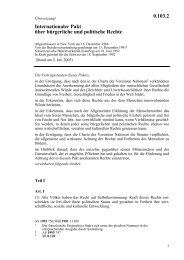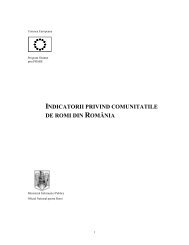Final Report of the International Commission on the - Minority Rights ...
Final Report of the International Commission on the - Minority Rights ...
Final Report of the International Commission on the - Minority Rights ...
Create successful ePaper yourself
Turn your PDF publications into a flip-book with our unique Google optimized e-Paper software.
Secuilor counties was carried out in accordance with <str<strong>on</strong>g>the</str<strong>on</strong>g> decisi<strong>on</strong> <str<strong>on</strong>g>of</str<strong>on</strong>g> a c<strong>on</strong>ference held in Târgu Mureş <strong>on</strong><br />
April 28, 1944. It was chaired by Endre and attended by all prefects, deputy prefects, mayors <str<strong>on</strong>g>of</str<strong>on</strong>g> cities,<br />
heads <str<strong>on</strong>g>of</str<strong>on</strong>g> districts, and top police and gendarmerie <str<strong>on</strong>g>of</str<strong>on</strong>g>ficers <str<strong>on</strong>g>of</str<strong>on</strong>g> <str<strong>on</strong>g>the</str<strong>on</strong>g> area. As decided at this c<strong>on</strong>ference, <str<strong>on</strong>g>the</str<strong>on</strong>g><br />
ghetto <str<strong>on</strong>g>of</str<strong>on</strong>g> Târgu Mureş held not <strong>on</strong>ly <str<strong>on</strong>g>the</str<strong>on</strong>g> local Jews but also those from <str<strong>on</strong>g>the</str<strong>on</strong>g> communities in Odorheiu<br />
County and <str<strong>on</strong>g>the</str<strong>on</strong>g> western part <str<strong>on</strong>g>of</str<strong>on</strong>g> Mureş-Turda County. The ghetto <str<strong>on</strong>g>of</str<strong>on</strong>g> Reghin held <str<strong>on</strong>g>the</str<strong>on</strong>g> Jews <str<strong>on</strong>g>of</str<strong>on</strong>g> <str<strong>on</strong>g>the</str<strong>on</strong>g><br />
communities in <str<strong>on</strong>g>the</str<strong>on</strong>g> eastern part <str<strong>on</strong>g>of</str<strong>on</strong>g> Mures-Turda County and <str<strong>on</strong>g>the</str<strong>on</strong>g> sou<str<strong>on</strong>g>the</str<strong>on</strong>g>rn part <str<strong>on</strong>g>of</str<strong>on</strong>g> Ciuc County. The ghetto<br />
<str<strong>on</strong>g>of</str<strong>on</strong>g> Sfântu Gheorghe was established for <str<strong>on</strong>g>the</str<strong>on</strong>g> Jews <str<strong>on</strong>g>of</str<strong>on</strong>g> Trei Scaune County and <str<strong>on</strong>g>the</str<strong>on</strong>g> sou<str<strong>on</strong>g>the</str<strong>on</strong>g>rn part <str<strong>on</strong>g>of</str<strong>on</strong>g> Ciuc<br />
County. As was <str<strong>on</strong>g>the</str<strong>on</strong>g> case everywhere else, <str<strong>on</strong>g>the</str<strong>on</strong>g> Jews <str<strong>on</strong>g>of</str<strong>on</strong>g> <str<strong>on</strong>g>the</str<strong>on</strong>g> various communities were first c<strong>on</strong>centrated in<br />
<str<strong>on</strong>g>the</str<strong>on</strong>g> local synagogues or community buildings before being transferred to <str<strong>on</strong>g>the</str<strong>on</strong>g> assigned ghettos.<br />
Târgu Mureş. The ghetto <str<strong>on</strong>g>of</str<strong>on</strong>g> Târgu Mureş was located in a dilapidated brickyard at Kor<strong>on</strong>kai Road<br />
that had an area <str<strong>on</strong>g>of</str<strong>on</strong>g> approximately 20,000 square meters. It had <strong>on</strong>e large building with a broken ro<str<strong>on</strong>g>of</str<strong>on</strong>g> and<br />
cement floors; since it had not been in use for several years, it was also extremely dirty. The ghetto<br />
populati<strong>on</strong> was 7,380 Jews, <str<strong>on</strong>g>of</str<strong>on</strong>g> whom approximately 5,500 were from <str<strong>on</strong>g>the</str<strong>on</strong>g> city itself and <str<strong>on</strong>g>the</str<strong>on</strong>g> o<str<strong>on</strong>g>the</str<strong>on</strong>g>rs from<br />
<str<strong>on</strong>g>the</str<strong>on</strong>g> communities in <str<strong>on</strong>g>the</str<strong>on</strong>g> several county districts, including Band, Miercurea Nirajului, Sângeorgiu de<br />
Pădure, and Teaca. Am<strong>on</strong>g <str<strong>on</strong>g>the</str<strong>on</strong>g>se were <str<strong>on</strong>g>the</str<strong>on</strong>g> 276 Jews <str<strong>on</strong>g>of</str<strong>on</strong>g> Sfântu Gheorghe and <str<strong>on</strong>g>the</str<strong>on</strong>g> Jews <str<strong>on</strong>g>of</str<strong>on</strong>g> Bezidu Nou,<br />
descendants <str<strong>on</strong>g>of</str<strong>on</strong>g> <str<strong>on</strong>g>the</str<strong>on</strong>g> Szekler who had c<strong>on</strong>verted to Judaism in <str<strong>on</strong>g>the</str<strong>on</strong>g> early days <str<strong>on</strong>g>of</str<strong>on</strong>g> <str<strong>on</strong>g>the</str<strong>on</strong>g> Transylvanian<br />
Principality. It was alleged that <str<strong>on</strong>g>the</str<strong>on</strong>g>se Jews were given a chance to escape ghettoizati<strong>on</strong> by declaring that<br />
that <str<strong>on</strong>g>the</str<strong>on</strong>g>y were Magyar Christians but, according to some sources, refused to do so.<br />
Approximately 2,400 <str<strong>on</strong>g>of</str<strong>on</strong>g> <str<strong>on</strong>g>the</str<strong>on</strong>g> 7,380 Jews in <str<strong>on</strong>g>the</str<strong>on</strong>g> brickyard, <str<strong>on</strong>g>the</str<strong>on</strong>g> largest ghetto in <str<strong>on</strong>g>the</str<strong>on</strong>g> area, found<br />
accommodati<strong>on</strong> in <str<strong>on</strong>g>the</str<strong>on</strong>g> brick-drying barns; <str<strong>on</strong>g>the</str<strong>on</strong>g> rest had to make do in <str<strong>on</strong>g>the</str<strong>on</strong>g> open. The commander <str<strong>on</strong>g>of</str<strong>on</strong>g> <str<strong>on</strong>g>the</str<strong>on</strong>g><br />
ghetto was police chief Géza Bedö; his deputy was Dezsö Liptai. The Jewish Council, which did its best<br />
to alleviate <str<strong>on</strong>g>the</str<strong>on</strong>g> plight <str<strong>on</strong>g>of</str<strong>on</strong>g> <str<strong>on</strong>g>the</str<strong>on</strong>g> Jews, included Samu Ábrahám, Mayer Csengeri, Mór Darvas, Ernö<br />
Goldstein, József Helmer, Dezsö Léderer, Jenö Schwimmer, Ernö Singer, and Manón Sz<str<strong>on</strong>g>of</str<strong>on</strong>g>er. C<strong>on</strong>diti<strong>on</strong>s<br />
in this ghetto were as miserable as <str<strong>on</strong>g>the</str<strong>on</strong>g>y were elsewhere; <str<strong>on</strong>g>the</str<strong>on</strong>g> water supply was particularly bad. Dr. Ádám<br />
Horváth, <str<strong>on</strong>g>the</str<strong>on</strong>g> city health <str<strong>on</strong>g>of</str<strong>on</strong>g>ficer, and his deputy, Dr. Mátyás Talos, were mainly resp<strong>on</strong>sible for <str<strong>on</strong>g>the</str<strong>on</strong>g> failure<br />
<str<strong>on</strong>g>of</str<strong>on</strong>g> <str<strong>on</strong>g>the</str<strong>on</strong>g> health and sanitary services in <str<strong>on</strong>g>the</str<strong>on</strong>g> ghetto.<br />
The Târgu Mureş Jews were c<strong>on</strong>centrated under <str<strong>on</strong>g>the</str<strong>on</strong>g> overall guidance <str<strong>on</strong>g>of</str<strong>on</strong>g> mayor Ferenc Májay, who<br />
had attended <str<strong>on</strong>g>the</str<strong>on</strong>g> c<strong>on</strong>ference called by Endre. In fact, Májay proceeded with <str<strong>on</strong>g>the</str<strong>on</strong>g> implementati<strong>on</strong> <str<strong>on</strong>g>of</str<strong>on</strong>g><br />
Endre’s directives just <strong>on</strong>e day after <str<strong>on</strong>g>the</str<strong>on</strong>g> c<strong>on</strong>ference, when he ordered that <str<strong>on</strong>g>the</str<strong>on</strong>g> main synagogue be turned<br />
into a makeshift hospital. The police and gendarmerie units directly involved in <str<strong>on</strong>g>the</str<strong>on</strong>g> ghettoizati<strong>on</strong> process<br />
were under <str<strong>on</strong>g>the</str<strong>on</strong>g> direct command <str<strong>on</strong>g>of</str<strong>on</strong>g> Col. János Papp, <str<strong>on</strong>g>the</str<strong>on</strong>g> head <str<strong>on</strong>g>of</str<strong>on</strong>g> <str<strong>on</strong>g>the</str<strong>on</strong>g> Gendarmerie Directorate in <str<strong>on</strong>g>the</str<strong>on</strong>g> four<br />
counties <str<strong>on</strong>g>of</str<strong>on</strong>g> <str<strong>on</strong>g>the</str<strong>on</strong>g> Ţara Secuilor; Col. János Zalantai, <str<strong>on</strong>g>the</str<strong>on</strong>g> commander <str<strong>on</strong>g>of</str<strong>on</strong>g> <str<strong>on</strong>g>the</str<strong>on</strong>g> Legi<strong>on</strong> <str<strong>on</strong>g>of</str<strong>on</strong>g> Gendarmes <str<strong>on</strong>g>of</str<strong>on</strong>g> Mureş-<br />
Turda County; and Géza Bedö. Leadership roles were also played by Col. Géza Körmendi, <str<strong>on</strong>g>the</str<strong>on</strong>g> head <str<strong>on</strong>g>of</str<strong>on</strong>g><br />
<str<strong>on</strong>g>the</str<strong>on</strong>g> H<strong>on</strong>véd units in <str<strong>on</strong>g>the</str<strong>on</strong>g> city and <str<strong>on</strong>g>the</str<strong>on</strong>g> county, and Gen. István Kozma, <str<strong>on</strong>g>the</str<strong>on</strong>g> head <str<strong>on</strong>g>of</str<strong>on</strong>g> <str<strong>on</strong>g>the</str<strong>on</strong>g> so-called Szekler<br />
Border Guard (Székely Határör) paramilitary organizati<strong>on</strong>. The involvement <str<strong>on</strong>g>of</str<strong>on</strong>g> <str<strong>on</strong>g>the</str<strong>on</strong>g>se H<strong>on</strong>véd (Hungarian<br />
armed forces) <str<strong>on</strong>g>of</str<strong>on</strong>g>ficials was excepti<strong>on</strong>al, inasmuch as regular military units were not normally involved in<br />
<str<strong>on</strong>g>the</str<strong>on</strong>g> ghettoizati<strong>on</strong> process. Kozma claimed that he had gotten involved at <str<strong>on</strong>g>the</str<strong>on</strong>g> pers<strong>on</strong>al request <str<strong>on</strong>g>of</str<strong>on</strong>g> Endre.<br />
Major Schröder, <str<strong>on</strong>g>the</str<strong>on</strong>g> local representative <str<strong>on</strong>g>of</str<strong>on</strong>g> <str<strong>on</strong>g>the</str<strong>on</strong>g> Gestapo, provided <str<strong>on</strong>g>the</str<strong>on</strong>g> technical assistance required for <str<strong>on</strong>g>the</str<strong>on</strong>g><br />
anti-Jewish operati<strong>on</strong>.<br />
The harshness and effectiveness <str<strong>on</strong>g>of</str<strong>on</strong>g> <str<strong>on</strong>g>the</str<strong>on</strong>g> local military-administrative authorities notwithstanding,<br />
Paksy-Kiss found much wanting in <str<strong>on</strong>g>the</str<strong>on</strong>g>ir operati<strong>on</strong> and provided a special unit <str<strong>on</strong>g>of</str<strong>on</strong>g> gendarmes for <str<strong>on</strong>g>the</str<strong>on</strong>g>ir<br />
assistance. The c<strong>on</strong>centrati<strong>on</strong> <str<strong>on</strong>g>of</str<strong>on</strong>g> <str<strong>on</strong>g>the</str<strong>on</strong>g> Jews was carried out with <str<strong>on</strong>g>the</str<strong>on</strong>g> help <str<strong>on</strong>g>of</str<strong>on</strong>g> <str<strong>on</strong>g>the</str<strong>on</strong>g> local chapter <str<strong>on</strong>g>of</str<strong>on</strong>g> <str<strong>on</strong>g>the</str<strong>on</strong>g> Levente<br />
paramilitary youth organizati<strong>on</strong>.<br />
Májay’s immediate collaborators in <str<strong>on</strong>g>the</str<strong>on</strong>g> launching and administrati<strong>on</strong> <str<strong>on</strong>g>of</str<strong>on</strong>g> <str<strong>on</strong>g>the</str<strong>on</strong>g> anti-Jewish measures in<br />
Târgu Mureş were Ferenc Henner, <str<strong>on</strong>g>the</str<strong>on</strong>g> head notary in <str<strong>on</strong>g>the</str<strong>on</strong>g> mayor’s <str<strong>on</strong>g>of</str<strong>on</strong>g>fice, and Ernö Jávor, <str<strong>on</strong>g>the</str<strong>on</strong>g> head notary


